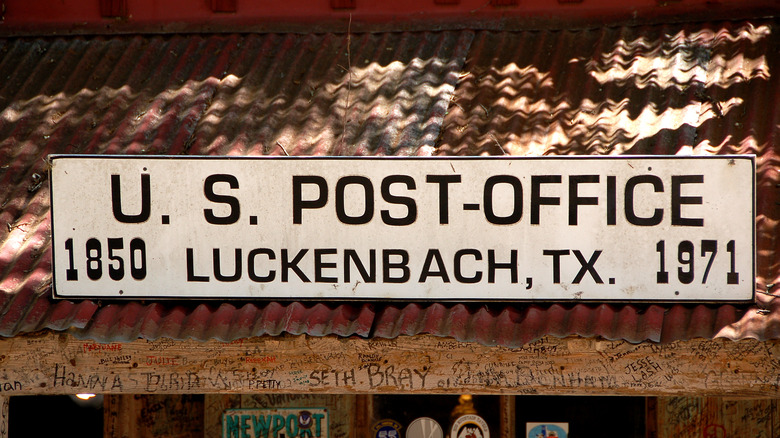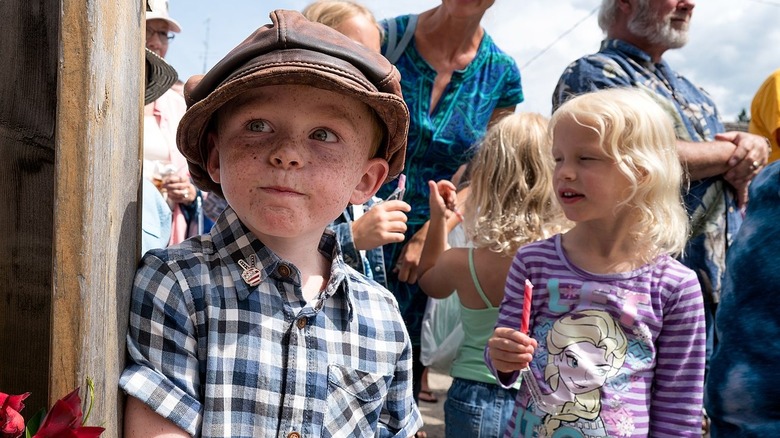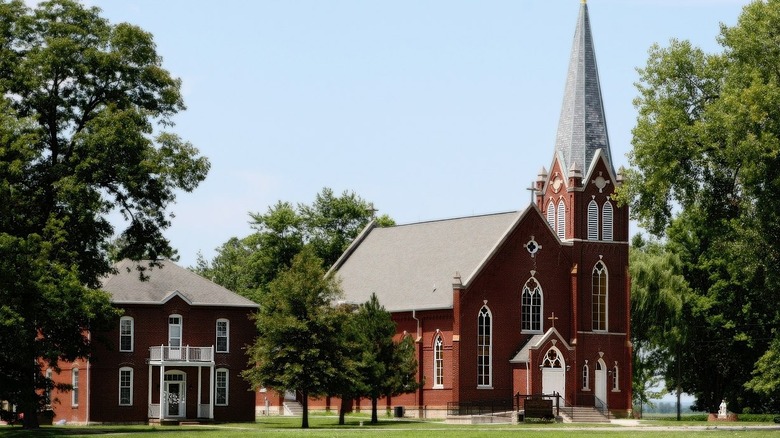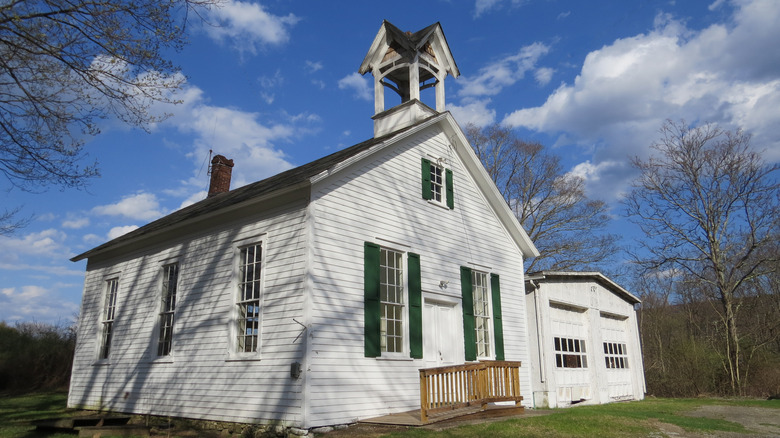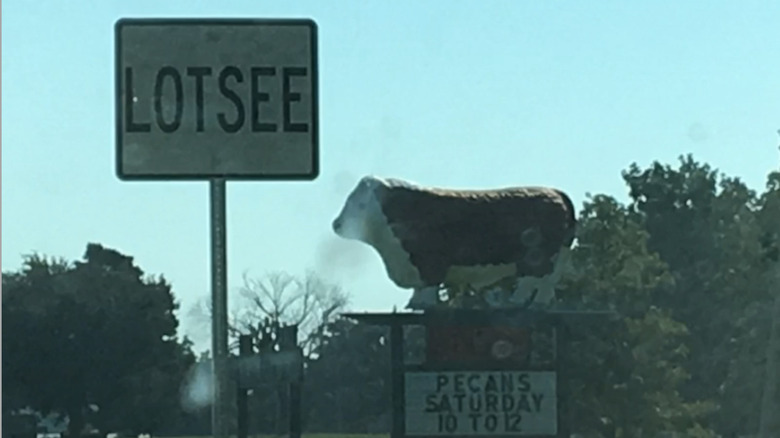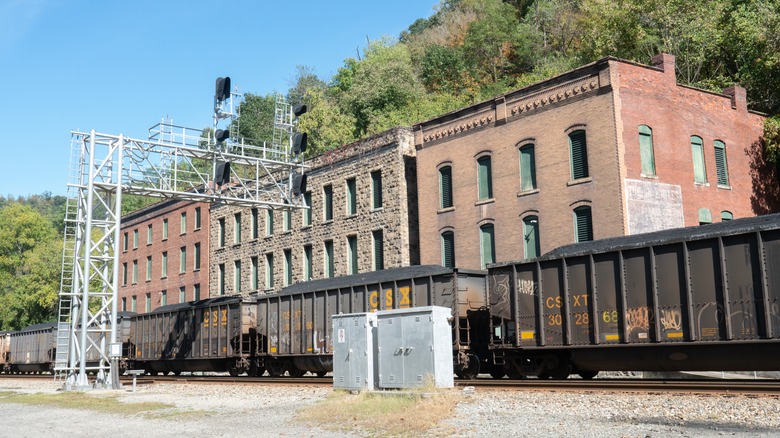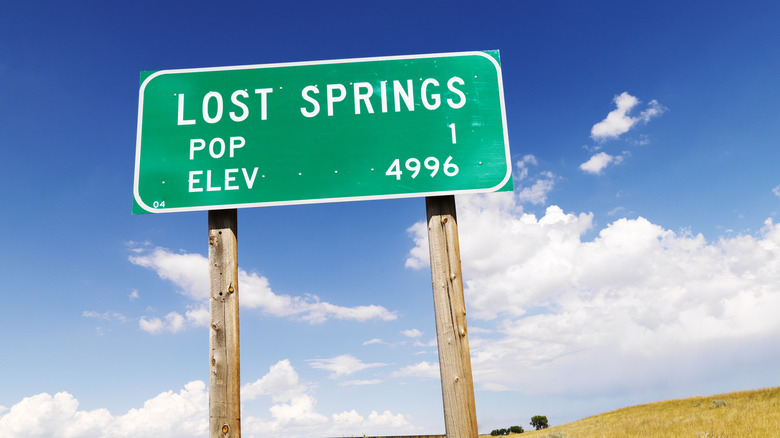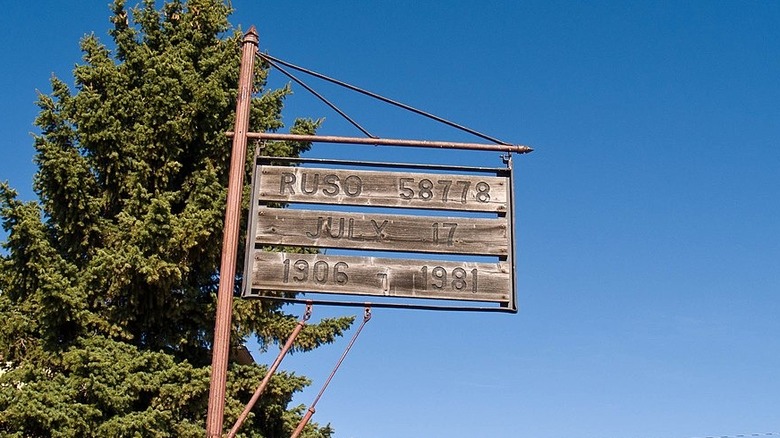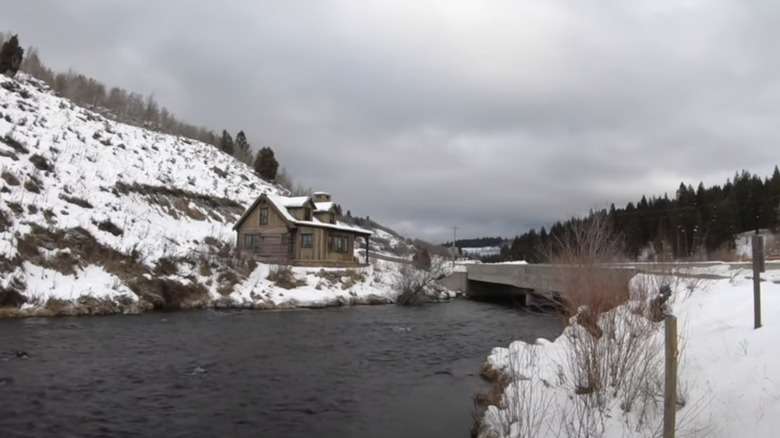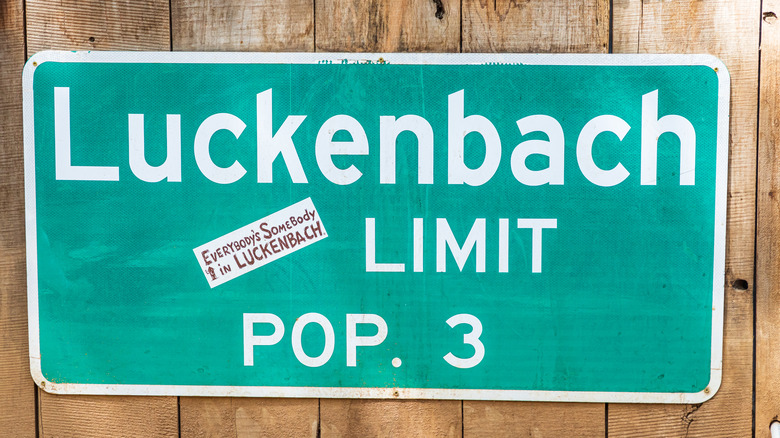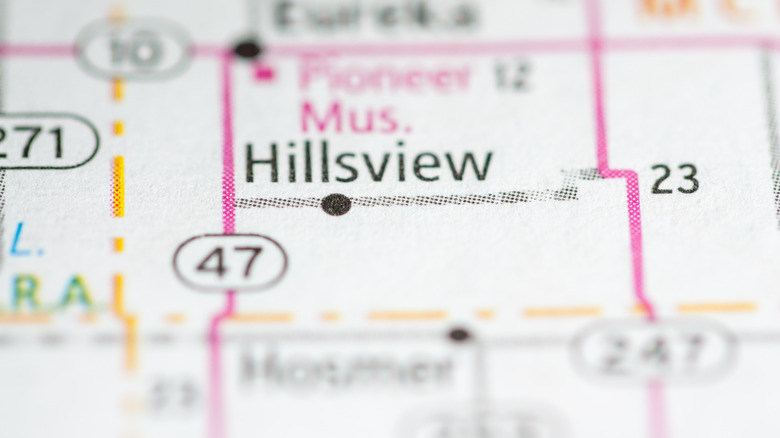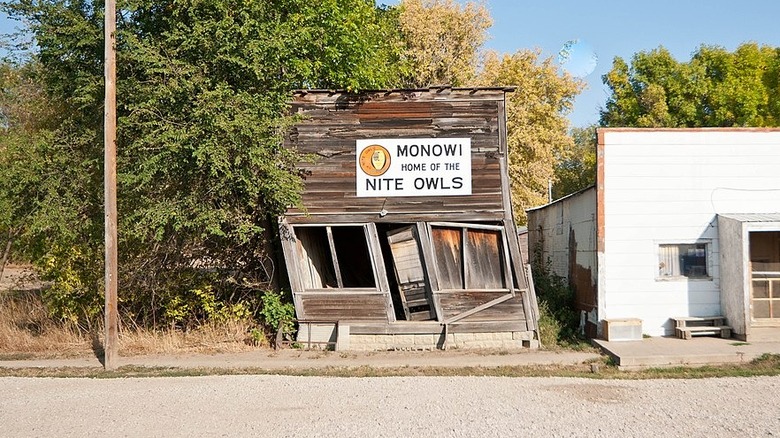US Cities With Less Than 100 People Living There
There's a tendency to associate the United States with sprawl and hugeness — Americans like to go big. But in reality, the U.S. is only the third-largest country in terms of population, according to World Population Review — and a distant third at that, with approximately 339 million people compared to India and China, with 1.4 billion each, as of 2022. And while many might think of big cities like New York, Los Angeles, or Chicago when America comes to mind, the United States Census Bureau noted in 2020 that about 76% of America's population lives in towns with populations of fewer than 5,000.
That means that there are a lot of small towns in the United States — and when we say small, we mean really, really small. Not only are there a lot of towns in this country with fewer than 100 people living within their borders, there are tons of towns with fewer than 10 people. In fact, it's not that hard to find a long list of towns in this country that have fewer than five people living in them.
Some of these places once had larger populations before economic or social conditions shifted, causing folks to move away. Some were incorporated in order to achieve specific legal goals, and some seem to exist solely as tourist attractions due to their tiny size. Whatever the reason, here are the most interesting U.S. cities with way, way fewer than 100 people living there.
Gilbert, Arkansas: Population, 24
According to its own website, the town of Gilbert was founded in 1902 by railroad workers, and for a while was sustained by a repair shop operated by the railroad, which shut down in 1946. According to AY Magazine, the town quickly prospered, sporting two hotels, multiple wood mills, a general store (established in 1901 and still in operation today), and a saloon that was tragically swept away in a flood in 1915. The town recovered — but when the railroad shut down — they even removed the tracks because of metal shortages during World War II — the town slid into a decline.
As of 2022, Gilbert has only 24 residents. It does have one major claim to fame: It is a meteorological oddity and officially the coldest town in Arkansas, a state not normally known for its chilly temperatures. Already a popular place to rent cabins and equipment for canoeing and other outdoor activities, its energetic mayor, Alvin "Chip" Johnson, has overseen various town projects, and intends to have the town designated a "dark sky" community — the first in Arkansas — to attract stargazers looking to escape the light pollution of more populous areas. According to the Arkansas Democrat-Gazette, the town even replaced its 16 street lights with LEDs to reduce light pollution.
Dorset, Minnesota: Population, 24
Life in Dorset, Minnesota, is just different. For one thing, as reported by CBS Minnesota, the town lays claim to the title of Restaurant Capital of the World, despite its small size. The reasoning? Sheer density: With four restaurants serving 24 residents, it sports one eatery for every six people, which no other city on earth can offer. Every year the town organizes Taste of Dorset (via Explore Minnesota), a food festival where tourists can sample some wares and play games.
According to Time, that event is also when the mayor of Dorset is selected for the coming year. A ceremonial post (the mayor has zero powers and duties), the mayor is picked out of a hat, and anyone willing to pay the $1 fee can run. Several mayors have lived outside Dorset, and several have been very young children. For example, Today reports that in 2015 the town "elected" 3-year-old James Tufts. James's older brother, Robert, served as mayor when he was three years old as well (he was even re-elected for a second term).
According to "Minnesota Place Names: A Geographical Encyclopedia," the town's history dates back to the late 19th century — a post office opened in 1898 and operated until 1964.
Kaskaskia, Illinois: Population, 21
You might not think a town with just 21 people, as of 2020 according to the United States Census Bureau (up from the 18 that The Chicago Tribune reported in 2019), would have a lot of interesting history, but Kaskaskia is the exception. FOX 2 News reports that the town takes its name from the indigenous people who had lived there before Europeans came to the area. After the French, British, and later Americans took control of the area, the town grew in population and importance (peaking at about 7,000 people), and when Illinois became a state in 1818, Kaskaskia was its first capital until 1819.
As noted by NPR Illinois, the town was frequently afflicted by devastating floods, tornadoes, and even earthquakes. More floods followed, and in the 1860s, the Mississippi River began to change course, eventually merging with the Kaskaskia River, and deforestation allowed the river to slowly wash the town away. The last original house in Kaskaskia dropped into the river in 1907.
The town was rebuilt, but the changing course of the river has left it as an island — and on the wrong side of the river, an enclave of Illinois inside the state of Missouri. By the 20th century, there were just 200 people left, but floods continued to plague the town, often submerging the town entirely. The fact that 21 brave souls remain is remarkable.
Walpack, New Jersey: Population, 12
Typically when you hear about tiny towns, there's either an eccentric group of people (or an eccentric individual) behind them or a story of slow, natural decline. Then there's Walpack Township, which was the victim of Ronald Reagan's old joke about the nine most terrifying words being "I'm from the government, and I'm here to help" (via Curtis Lokey).
The Walpack Historical Society reports that the history of the town dates back to the 18th century, and it hit a peak population of 851 in the 1860s. By 1960, the population was a still-robust 248 people — but as noted by NorthJersey.com, that's when everything started to go wrong for the small town. A series of hurricanes killed about 100 people in the Delaware Valley in 1955, and a plan was created to dam the river to prevent future flooding. Walpack Township was a victim of this plan, and an underfunded Army Corps of Engineers began forcing residents to sell their homes — often at insultingly low prices — in the 1960s.
But the Corps mishandled the project, renting the houses they'd just forced people to sell in order to get more funds and sometimes bulldozing houses they hadn't actually purchased yet. Meanwhile, no work on the dam was done, and by 1978 the project was dead — but so was Walpack.
According to Patch, about 12 people were still reported to live there in 2022, and the National Park Service has done a lot of work to preserve the town.
Lotsee, Oklahoma: 6
Reader's Digest reports that Lotsee, Oklahoma was once a private ranch owned by a man named George Campbell. According to The Oklahoman, Campbell frequently rented his land to church groups and Boy Scout troops for camping and other activities and events — he and his wife Garnett even built a large swimming pool on the property — but in the early 1960s, the nearby cities of Tulsa and Sands Springs were engaged in aggressive development campaigns (per The Oklahoman), and Campbell worried that this would inhibit his ability to run the ranch as he wished and rent out the grounds. So, taking advantage of the ranch's obscurity, he quietly incorporated it as a town to strengthen his legal footing if he had to fend off efforts to develop the area — and he named the town after his daughter.
According to iHeart, Lotsee's population peaked at 16 in 1970 and had dropped to seven by 1980. According to the 2020 U.S. Census (via the United States Census Bureau), Lotsee is down to just six people, though the town has also dropped to as few as two inhabitants in prior years. The ranch is no longer commonly used for camping — Lotsee Spradling and her family use the land as a working ranch, growing pecans, raising cattle, and running an equestrian business. Lotsee believes that incorporating the ranch as a town saved it — and the lifestyle she loves — from being swallowed up by nearby urban areas.
Thurmond, West Virginia: Population, 5
USA Today reports that Thurmond, West Virginia, once boasted a population of about 500. But as of 2020, the official U.S. Census count is five folks. The town was incorporated in 1873, located at an ideal spot for transporting coal and lumber. In its heyday, the town sported two banks, two hotels, and even a movie theater. The Great Depression took a toll, however — Atlas Obscura reports that by 1935 only one bank was left in Thurmond, and its collapse was a final step in a long decline precipitated by changing railroad technology — Thurmond's rail yard couldn't handle newer diesel trains.
Today the town is overseen and maintained in large part by the National Park Service, and exists as a kind of open-air museum of what was. But people do still live there — The Washington Post reports that all five residents are part of the local government, with a mayor, town recorder, and three council members.
One of Thurmond's hotels, the Dunglen, was pretty famous in its day: As noted by "Historic Inns of Southern West Virginia," the Dunglen was built in 1901, sported 100 rooms, and had a mall of small businesses on its first floor. It was pretty fancy, and earned the nickname "Little Monte Carlo." The hotel, rumored to be the site of a 14-year poker game according to "West Virginia Off the Beaten Path," burned down in 1930 — just one more step in the town's descent.
Lost Springs, Wyoming: Population, 4
Lost Springs, Wyoming, is one of the few very, very small towns that has actually seen some population growth. As noted by Roadside America, the tiny town's city limits sign once boasted exactly one resident, but The Washington Post noted in 2001 that the mayor complained the Census had missed two of the town's three residents — and as of 2021, the population has since risen to four. That's a 300% increase, which would be impressive if we were talking about hundreds or thousands of residents.
The town, named by railroad workers who couldn't locate the springs supposedly dotting the area, has roots that go back to the 1880s. According to Atlas Obscura, it was officially incorporated in 1911. Buoyed by work at the nearby coal mines, its population peaked at around 150 in the 1920s, according to The Washington Post, but the mine closed, and by 1950 only nine folks remained.
The town survives on a trickle of curious tourists who are drawn in by the road sign. According to Reader's Digest, all you'll find in Lost Springs is a bar, a general store, and some outhouses — and at least four people — but the town hall is also used regularly for weddings and other receptions, and hosts an annual auction that attracts hundreds of folks.
Ruso, North Dakota: Population, 4
As noted by AP News, North Dakota has a lot of very small communities with fewer than 20 people. However, its smallest town is Ruso, which currently boasts four residents — and which was almost dissolved just a few years ago.
The Minot Daily News reports that Ruso's population had grown to 141 people just one year after its founding in 1909. It sported a doctor, a few grocery stores, and a Lutheran Church that was a key part of the town's life. But things went into a steady decline, and by 1956 the town's sole business, a grain elevator, shut down. The church shut down in 1997, and by then the only thing keeping the lights on were the property taxes that several out-of-towners paid on lots they'd purchased within the town's borders.
According to CBS Minnesota, a man named Bruce Lorenz was mayor of Ruso for more than thirty years while the town's population hovered at three — the minimum number required for an official town under North Dakota law. When Lorenz passed away in 2018, the town's population dropped to two, and it was feared that it would have to become unincorporated. Then it was discovered that one of the landowners, Greg Schmaltz, qualified as a legal resident because he maintains an address there — and he agreed to become the town's new mayor. Along with his wife, that brought the population back to four — allowing Ruso to remain a town.
Warm River, Idaho: Population, 3
According to the U.S. Census (via Data Commons), Warm River, Idaho, had as many as 11 residents as recently as the 1990s, but City-Data.com reports that by 2019 the town currently boasted exactly three. Reader's Digest explains that the area butts up against the Caribou-Traghee National Forest and is a popular spot for outdoor activities, including tubing and fishing in the Warm River itself.
So, yes, it's a glorified campsite — but it is an official, legally-incorporated town because of the liquor laws in Idaho, which restrict liquor licenses to incorporated towns. As reported by AP (via KBOI IdahoNews), in 1947, Estonian immigrant Fred Lewies legally incorporated the town because he wanted to serve alcohol at his dance hall. According to the Freemont County Historical Society, Fred's wife Berta served as the first mayor of the town, and Lewies family members have served in the post ever since — in 2013, the entire town government was composed of extended Lewies family, as well as several of their employees at the dance hall and resort they run.
According to Only in Your State, Warm River attracts a large population of tourists every year as people seek out its natural beauty and world-class fishing. And thanks to the foresight and determination of Fred Lewies, they can now get a drink at the dance hall if they're so inclined.
Luckenbach, Texas: Population, 3
It's not every tiny town in America that has a song about them performed by a country music legend, but Luckenbach, Texas, does (via Midnightryder3). The Texas State Historical Association reports that the town was settled in the 1840s by a group of German immigrants, including brothers Jacob and August Luckenbach. The town was officially named Luckenbach in 1886. By 1904 the town had reached the zenith of its population, with 492 folks living there. It's been a steady decline since, and Newsweek reported in 2021 that its population had dwindled to just three.
For such a small town, Luckenbach has had an outsized place in Texas culture. Southern Living reports that the entire town was put up for sale in 1970, and a local man named John Russell Crouch (nicknamed Hondo after his hometown) pulled together some investors and bought the place. According to Texas Monthly, Crouch was a legendary writer, humorist, and musician, and he turned the tiny town into a hub for country music. Classic albums were recorded there, and big stars showed up to play concerts (including legend Willie Nelson, who the Austin American-Statesman notes hosted several Fourth of July Picnics there).
Interestingly, the town's population has been remarkably steady — the original 1970s advertisement offering it up for sale read "town for sale, pop. 3," which does not appear to have shifted in half a century.
Hillsview, South Dakota: Population, 2
According to The Bismarck Tribune, Hillsview, South Dakota, was once a thriving small town with a population of a few hundred, a school, a post office, and a bank. Today it's home to exactly two people: Helen and Cletus Imberi — it was three until 2016, when Reader's Digest reports Helen's husband and lifelong Hillsview resident Jim Imberi passed away. Two other people own land in the town limits and are members of its board of trustees, but don't actually live there.
Jim had been committed to keeping his hometown alive. With Helen serving as treasurer, the Imberi's used county transportation allotments to have street lights installed to keep the town lit up at night, even though there aren't any usable buildings left aside from the Imberi's home. The state removed the road signs pointing to the town years ago, arguing that they couldn't direct people to a town with zero services. No one thinks the town can be revived or saved — there's not a lot of economic opportunity to lure people to Hillsview.
According to KXRB Radio, Hillsview was incorporated in 1887, and in the early 20th century, it had grown to about 100 people. With just two people left, however, it's only a matter of time before it transitions into official ghost town status.
Monowi, Nebraska: Population, 1
As noted by The Boston Globe, Monowi, Nebraska, made news when the 2020 census reported that its population had doubled from one to two people. Since the town has been occupied by its sole mayor, librarian, tax collector (and payer), and tavern owner, Elsie Eiler, since her husband passed away in 2004, according to Newsweek, this was a surprise. As it turns out, the second person doesn't actually exist, and the Census Bureau knows it. According to the Omaha World-Herald, the second person was added purposefully as "noise" designed to protect people's privacy.
BBC Travel reports that Monowi, like many towns in the Midwestern United States, was once a bustling little burg of about 150, with a strong business district. Eiler met her husband, Rudy, in Monowi, and they opened the Monowi Tavern in 1971. But by then, the town had already begun to collapse — the post office was closed by 1970, the school shut down in 1974, and by 1980 there were only 18 people left in town. By the year 2000, it was just Rudy and Elise.
Surprisingly, the tavern does a brisk business as folks in the general area drive in to have lunch and say hello to Elise, and a public library was established after her husband's death, honoring his final wish. The library is open to anyone who wants to borrow a book, and is run on the honor system.
